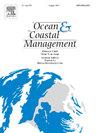First assessment of mercury bioaccumulation in jumbo squid (Dosidicus gigas) off Peru: The impact of sized group, sex, and feeding ecology
IF 5.4
2区 环境科学与生态学
Q1 OCEANOGRAPHY
引用次数: 0
Abstract
Jumbo squid, Dosidicus gigas, play a crucial role in marine ecosystems and are an important commercial species in the East Pacific. This study investigated the bioaccumulation characteristics of total mercury (THg) in jumbo squid (Dosidicus gigas) from the eastern Pacific Ocean, analyzing the influence of factors such as mantle length, sex, and feeding ecology. We analyzed the muscle tissue of 108 squid samples (small, medium, and large-sized groups) collected from June to December 2020. THg concentrations increased with mantle length, but all values remained within Chinese national edible standards. Females in medium and large-sized groups had significantly higher THg concentrations than males. Stable isotope (δ13C and δ15N) and fatty acid analyses revealed the feeding habits and trophic levels of different groups and their correlation with THg levels. Principal component analysis (PCA) identified body weight, δ13C, Eicosapentaenoic Acid, and THg as significant contributors to the first principal component, while Arachidonic Acid contributed to the second. Correlations between THg, δ13C, δ15N, and the Docosahexaenoic Acid/Eicosatetraenoic Acid ratio varied among groups. These findings highlight the importance of pollutant bioaccumulation research in cephalopods, providing insights into the biogeochemical cycling of pollutants in marine ecosystems. This study not only provides data on mercury levels in the muscles of giant squid, which can help evaluate the health risks of human consumption, but also suggest that future research should focus on the integration of pollutant research with biogeochemical techniques.

秘鲁巨型鱿鱼(Dosidicus gigas)中汞生物积累的首次评估:大小群体,性别和摄食生态的影响
巨型鱿鱼(Dosidicus gigas)在海洋生态系统中起着至关重要的作用,是东太平洋重要的商业物种。研究了东太平洋巨型鱿鱼(Dosidicus gigas)体内总汞(THg)的生物积累特征,分析了地幔长度、性别和摄食生态等因素对其的影响。我们分析了2020年6月至12月收集的108个鱿鱼样本(小、中、大组)的肌肉组织。THg浓度随衣套长度的增加而增加,但均在中国国家食用标准范围内。中、大型组雌性THg浓度显著高于雄性。稳定同位素(δ13C和δ15N)和脂肪酸分析揭示了不同类群的摄食习性、营养水平及其与THg水平的相关性。主成分分析(PCA)发现,体重、δ13C、二十碳五烯酸和THg对第一个主成分有显著贡献,而花生四烯酸对第二个主成分有显著贡献。THg、δ13C、δ15N与二十二碳六烯酸/二十碳四烯酸比值的相关性在不同组间存在差异。这些发现突出了头足类动物污染物生物积累研究的重要性,为海洋生态系统中污染物的生物地球化学循环提供了见解。该研究不仅提供了巨乌贼肌肉中汞含量的数据,有助于评估人类食用巨乌贼的健康风险,而且还建议未来的研究应侧重于将污染物研究与生物地球化学技术相结合。
本文章由计算机程序翻译,如有差异,请以英文原文为准。
求助全文
约1分钟内获得全文
求助全文
来源期刊

Ocean & Coastal Management
环境科学-海洋学
CiteScore
8.50
自引率
15.20%
发文量
321
审稿时长
60 days
期刊介绍:
Ocean & Coastal Management is the leading international journal dedicated to the study of all aspects of ocean and coastal management from the global to local levels.
We publish rigorously peer-reviewed manuscripts from all disciplines, and inter-/trans-disciplinary and co-designed research, but all submissions must make clear the relevance to management and/or governance issues relevant to the sustainable development and conservation of oceans and coasts.
Comparative studies (from sub-national to trans-national cases, and other management / policy arenas) are encouraged, as are studies that critically assess current management practices and governance approaches. Submissions involving robust analysis, development of theory, and improvement of management practice are especially welcome.
 求助内容:
求助内容: 应助结果提醒方式:
应助结果提醒方式:


